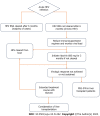Hepatitis E infection: A review
- PMID: 38187497
- PMCID: PMC10768387
- DOI: 10.5501/wjv.v12.i5.262
Hepatitis E infection: A review
Abstract
Hepatitis E virus (HEV) is a small non-enveloped virus that is transmitted via the fecal-oral route. It is a highly common cause of acute hepatitis, particularly in low to middle income regions of Asia, Africa, and Central America. Most cases are self-limited, and symptomatic patients usually present with acute icteric hepatitis. A subset of patients including pregnant women, older men, those with pre-existing liver disease and immunocompromised patients however, may develop severe disease and hepatic failure. Immunocompromised patients are also at risk for chronic infection, and their immunosuppression should be decreased in order to facilitate viral clearance. HEV can also present with a variety of extra-intestinal manifestations including neurological, renal, hematological, and pancreatic derangements. The gold standard of diagnosis is HEV ribonucleic acid detection via nucleic acid amplification testing. Currently, there are no approved treatments for Hepatitis E, though ribavirin is the most commonly used agent to reduce viral load. Studies assessing the safety and efficacy of other antiviral agents for HEV are currently underway. HEV vaccination has been approved in China, and is currently being investigated in other regions as well. This review article aims to discuss the epidemiology, pathogenesis, presentation, diagnosis, complications, and treatment of Hepatitis E infection.
Keywords: Acute hepatitis; Chronic hepatitis; Hepatitis E; Vaccination; Viral hepatitis.
©The Author(s) 2023. Published by Baishideng Publishing Group Inc. All rights reserved.
Conflict of interest statement
Conflict-of-interest statement: There are no conflicts of interest associated with any of the authors of this manuscript.
Figures




Similar articles
-
Hepatitis E in immunocompromised individuals.World J Hepatol. 2022 Mar 27;14(3):482-494. doi: 10.4254/wjh.v14.i3.482. World J Hepatol. 2022. PMID: 35582299 Free PMC article. Review.
-
Clinical Manifestations, Pathogenesis and Treatment of Hepatitis E Virus Infections.J Clin Med. 2020 Jan 24;9(2):331. doi: 10.3390/jcm9020331. J Clin Med. 2020. PMID: 31991629 Free PMC article. Review.
-
Treatment Options for Hepatitis A and E: A Non-Systematic Review.Viruses. 2023 Apr 28;15(5):1080. doi: 10.3390/v15051080. Viruses. 2023. PMID: 37243166 Free PMC article. Review.
-
Hepatitis E Virus Infections: Epidemiology, Genetic Diversity, and Clinical Considerations.Viruses. 2023 Jun 17;15(6):1389. doi: 10.3390/v15061389. Viruses. 2023. PMID: 37376687 Free PMC article. Review.
-
Hepatitis E Virus Infection in Lung Transplant Recipients: A Case Series.Transplant Proc. 2019 Mar;51(2):376-379. doi: 10.1016/j.transproceed.2018.10.006. Epub 2018 Oct 28. Transplant Proc. 2019. PMID: 30879545
Cited by
-
Neurological Manifestations of HEV Infection: A Rare Phenomenon or an Underrecognized Reality?Brain Behav. 2025 Jun;15(6):e70585. doi: 10.1002/brb3.70585. Brain Behav. 2025. PMID: 40534221 Free PMC article.
-
Seroprevalence of the Hepatitis E Virus in Indigenous and Non-Indigenous Communities from the Brazilian Amazon Basin.Microorganisms. 2024 Feb 10;12(2):365. doi: 10.3390/microorganisms12020365. Microorganisms. 2024. PMID: 38399768 Free PMC article.
-
Hepatitis E in the pediatric population: An overlooked disease but a genuine concern?Clin Exp Hepatol. 2025 Jun;11(2):97-104. doi: 10.5114/ceh.2025.151583. Epub 2025 Jun 5. Clin Exp Hepatol. 2025. PMID: 40904664 Free PMC article. Review.
-
Viral Hepatitis: Host Immune Interaction, Pathogenesis and New Therapeutic Strategies.Pathogens. 2024 Sep 5;13(9):766. doi: 10.3390/pathogens13090766. Pathogens. 2024. PMID: 39338957 Free PMC article. Review.
-
Evaluating the Efficacy and Safety of Hepatitis E Vaccination in Reproductive-Age Women: A Systematic Review and Meta-Analysis.Vaccines (Basel). 2025 Jan 9;13(1):53. doi: 10.3390/vaccines13010053. Vaccines (Basel). 2025. PMID: 39852832 Free PMC article. Review.
References
-
- Kamar N, Bendall R, Legrand-Abravanel F, Xia NS, Ijaz S, Izopet J, Dalton HR. Hepatitis E. Lancet. 2012;379:2477–2488. - PubMed
-
- Petrik J, Lozano M, Seed CR, Faddy HM, Keller AJ, Prado Scuracchio PS, Wendel S, Andonov A, Fearon M, Delage G, Zhang J, Shih JW, Gallian P, Djoudi R, Tiberghien P, Izopet J, Dreier J, Vollmer T, Knabbe C, Aggarwal R, Goel A, Ciccaglione AR, Matsubayashi K, Satake M, Tadokoro K, Jeong SH, Zaaijer HL, Zhiburt E, Chay J, Teo D, Chua SS, Piron M, Sauleda S, Echevarría JM, Dalton H, Stramer SL. Hepatitis E. Vox Sang. 2016;110:93–130. - PubMed
-
- Meng XJ. Hepatitis E virus. Viral Infections of Humans: Epidemiology and Control 2023; 1-37.
-
- "Hepatitis E. " World Health Organization. Accessed 19 July 2023. Available from: www.who.int/news-room/fact-sheets/detail/hepatitis-e .
-
- Rein DB, Stevens GA, Theaker J, Wittenborn JS, Wiersma ST. The global burden of hepatitis E virus genotypes 1 and 2 in 2005. Hepatology. 2012;55:988–997. - PubMed

